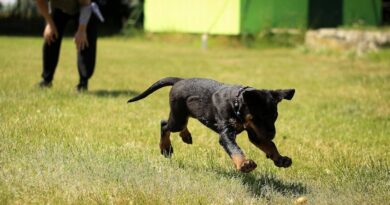Tips for Managing Dog Separation Anxiety
It’s a common scenario for many dog owners – you leave the house for work, errands, or even just a short trip to the store, only to return to find your furry friend has wreaked havoc in your absence. From chewed-up furniture to incessant barking, these behaviors are often signs of separation anxiety in dogs. Just like humans, dogs can experience feelings of distress when separated from their owners, leading to destructive behaviors and emotional turmoil.
In this comprehensive guide, we will delve deep into the world of managing dog separation anxiety. From understanding the root causes to implementing effective strategies, we will explore various tips and techniques to help both you and your canine companion navigate this challenging issue. Let’s embark on this journey together and discover how to create a harmonious environment for your beloved pet.
The Origins of Separation Anxiety in Dogs
Before we delve into the management strategies, it’s crucial to understand the origins of separation anxiety in dogs. This condition can manifest for a variety of reasons, including:
- Past Trauma: Dogs that have experienced abandonment, rehoming, or a traumatic event in the past may develop separation anxiety as a result of these experiences.
- Over-Attachment: Dogs that have formed an overly strong bond with their owners may struggle to cope with separation, leading to anxiety and distress.
- Changes in Routine: Any sudden changes in routine, such as a new work schedule or a shift in the household dynamics, can trigger separation anxiety in dogs.
By identifying the underlying causes of your dog’s separation anxiety, you can tailor your management approach to suit their specific needs and alleviate their distress.
Creating a Safe and Comfortable Environment
One of the first steps in managing dog separation anxiety is to create a safe and comfortable environment for your pet. This includes:
- Designated Safe Space: Provide your dog with a designated safe space, such as a cozy bed or crate, where they can retreat when feeling anxious or overwhelmed.
- Comforting Objects: Introduce comforting objects, such as a favorite toy or blanket, that carry familiar scents and provide a sense of security for your dog.
- Calming Music: Playing soothing music or white noise in the background can help create a calming atmosphere and reduce your dog’s anxiety levels.
By creating a safe and comfortable environment, you can help your dog feel more secure and relaxed during periods of separation.
Gradual Desensitization Techniques
Gradual desensitization is a common technique used to help dogs overcome separation anxiety. This involves gradually exposing your dog to situations of separation in a controlled and systematic manner. Some strategies for gradual desensitization include:
- Short Absences: Start by leaving your dog alone for short periods of time, gradually increasing the duration as they become more comfortable with the separation.
- Practice Departure Cues: Practice your departure cues, such as picking up your keys or putting on your coat, without actually leaving the house to desensitize your dog to these triggers.
- Use Treats and Rewards: Reward your dog for calm and relaxed behavior during periods of separation to reinforce positive associations with being alone.
By implementing gradual desensitization techniques, you can help your dog build confidence and resilience when faced with separation.
Exercise and Mental Stimulation
Regular exercise and mental stimulation are essential components of managing dog separation anxiety. Physical activity not only helps your dog release pent-up energy but also promotes mental well-being. Some ways to incorporate exercise and mental stimulation into your dog’s routine include:
- Daily Walks: Take your dog for daily walks to provide physical exercise and mental stimulation through exploration of the environment.
- Interactive Toys: Use interactive toys, such as puzzle feeders or treat-dispensing toys, to keep your dog engaged and mentally stimulated when alone.
- Training Sessions: Engage in regular training sessions with your dog to provide mental enrichment and strengthen the bond between you.
By incorporating exercise and mental stimulation into your dog’s daily routine, you can help alleviate anxiety and promote overall well-being.
Seeking Professional Help
If your dog’s separation anxiety persists despite your best efforts, it may be beneficial to seek professional help. A qualified veterinarian or animal behaviorist can provide personalized guidance and support to address your dog’s specific needs. Some avenues for professional help include:
- Behavior Modification Therapy: A behaviorist can work with you and your dog to develop a customized behavior modification plan to address separation anxiety.
- Medication: In severe cases, medication may be prescribed to help manage your dog’s anxiety levels and facilitate the behavior modification process.
- Support Groups: Joining support groups or online forums for dog owners dealing with separation anxiety can provide valuable insights and emotional support.
Remember, seeking professional help is not a sign of failure but a proactive step towards ensuring the well-being of your furry friend.
Establishing a Consistent Routine
Consistency is key when managing dog separation anxiety. Establishing a consistent routine helps your dog feel secure and predict the daily events, reducing anxiety and promoting a sense of stability. Some tips for establishing a consistent routine include:
- Regular Feeding Schedule: Feed your dog at the same times each day to establish a predictable routine and maintain their physical well-being.
- Set Departure Rituals: Create a set of departure rituals that signal to your dog that you will be leaving, helping them prepare for your absence.
- Stick to a Schedule: Try to stick to a consistent schedule for walks, playtime, and other activities to create a sense of normalcy for your dog.
By establishing a consistent routine, you can provide a sense of structure and security for your dog, helping them feel more at ease during periods of separation.
Patience and Understanding
Managing dog separation anxiety is a journey that requires patience and understanding. It’s essential to approach the process with empathy and compassion, recognizing that your dog’s anxiety is a genuine emotional response that needs to be addressed with care. Some key points to keep in mind include:
- Be Patient: Progress may be slow, and setbacks may occur, but with patience and consistency, you can help your dog overcome separation anxiety.
- Stay Calm: Dogs are highly attuned to their owners’ emotions, so it’s crucial to remain calm and composed when addressing separation anxiety.
- Celebrate Small Victories: Acknowledge and celebrate small improvements in your dog’s behavior to reinforce positive changes and encourage further progress.
Remember, managing dog separation anxiety is a process that requires time, effort, and dedication. By approaching the journey with patience and understanding, you can create a supportive environment for your dog to thrive.
Conclusion
To wrap things up, managing dog separation anxiety is a multifaceted process that requires a combination of strategies, patience, and understanding. By addressing the root causes, creating a safe environment, implementing gradual desensitization techniques, and seeking professional help when needed, you can help your dog overcome separation anxiety and lead a happier, more fulfilling life.
Remember, each dog is unique, and what works for one may not work for another. It’s essential to tailor your approach to your dog’s specific needs and respond with empathy and compassion throughout the journey. By working together with your furry friend, you can build a stronger bond and create a harmonious relationship based on trust and understanding.




